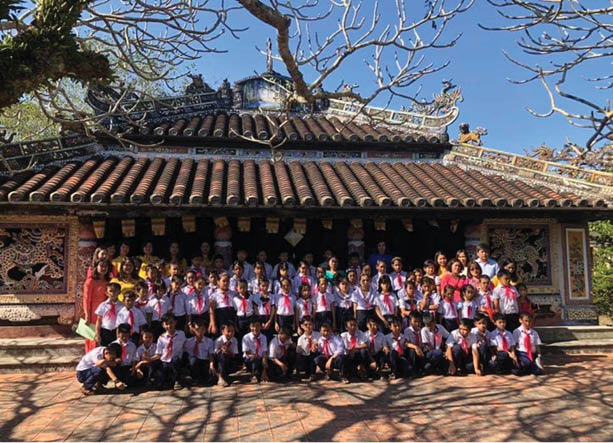
The frangipani tree in front of the main hall existing for over 2 centuries
Giac Luong Pagoda is more than 100 meters away from Hien Luong village entrance. Since the Pagoda is located in the low-lying area of Phong Dien district, traces of the recent floods are still clearly visible on the brick yard and walls. The Pagoda, which has an ancient communal architecture, still persists after the disaster.
Mr. Hai affirmed that visiting the Pagoda did not depend on the weather, so even though the day that we visited the Pagoda was also the time when the entire Central strip of land was in for the storm No. 10, the view inside the Pagoda was still airy and dignified despite the uneven rain.
As Mr. Hai introduces, the 3-storey gate is truly magnificent as compared to the humble ancient Pagoda inside. Mr. Nguyen Duc Thien, who succeeds his father to be responsible for the incense burning at the Pagoda, said that according to the elderly in the village, the Pagoda was built by Mrs. Hoang Thi Phu more than two centuries ago to worship Buddha and the gods. In addition, the builder also intentionally created a worshipping place for the new-land-openers and the first 12 families living in Hien Luong village to remind their descendants of their ancestors.
Mr. Thien emphasized that not many pagodas in Hue have the construction of a three-door gate, not to mention an altar to worship the guardian of the pagoda on the second floor of the gate. According to local people, this altar is very sacred.

Many schools organizing field trips to Giac Luong Pagoda for students
It was fortunate for me to meet with the 80-year-old Aunty Tran Thi Bien, who was born and who grows up in Hien Luong village. She said: “During the war, the Pagoda became a sanctuary for many officials. During the uprising of Mau Than, bombs were scattered throughout the village, but the Pagoda was safe and sound”.
Perhaps due to those good impressions, the Pagoda has received absolutely no funds for refurbishment or restoration for a long time. Offerings and money that people bring for praying on the occasion of Tet are not enough for buying flowers and incense. However, villagers still voluntarily contribute to refurbishing, incense burning, and keeping the Pagoda’s intact.
Mrs. Bien shared: "When I was still healthy and free, I used to sweep the yard. Now that I have been too old, I could not do that anymore; just coming here to enjoy the fresh air can help me feel comfortable and relaxed."
According to Mr. Thien, his father, Mr. Nguyen Dac Dinh, had been the former abbot of the Pagoda for many years. When his father passed away five years ago, Thien succeeded his father to be responsible for the incense burning. However, he could not handle this alone. In fact, thanks to the help of local people (sweeping the yard, weeding, planting trees, etc.), the Pagoda’s space is always clean and incense and offerings are not always short of.
Returning to my fatherland after the reunification of the country, I notice more than a dozen of frangipani trees with red and yellow flowers in my garden. Although they are several decades old up to now, only the ancient frangipani tree in Giac Luong Pagoda can impress me.
Located on the right side of the main hall of the Pagoda, the tree has a big stump and many soaring branches that give shade to half of the Pagoda yard. Over time, I wonder how many natural disasters, storms and floods have hit the tree, yet it still firmly persists.
With the quiet and airy space, together with the cultural and historical values, for many years Giac Luong Pagoda has become a field trip destination for students chosen by Head teachers and General Chiefs of the School Young Pioneer Union in Phong Dien district and neighboring localities.
Mr. Nguyen Phi Hung, Head of Education and Training Department of Phong Dien district said: "From Giac Luong Pagoda, we will do research and seek for more educational destinations right in the local area to organize tours for students."
Story & photos: Huong Lan
